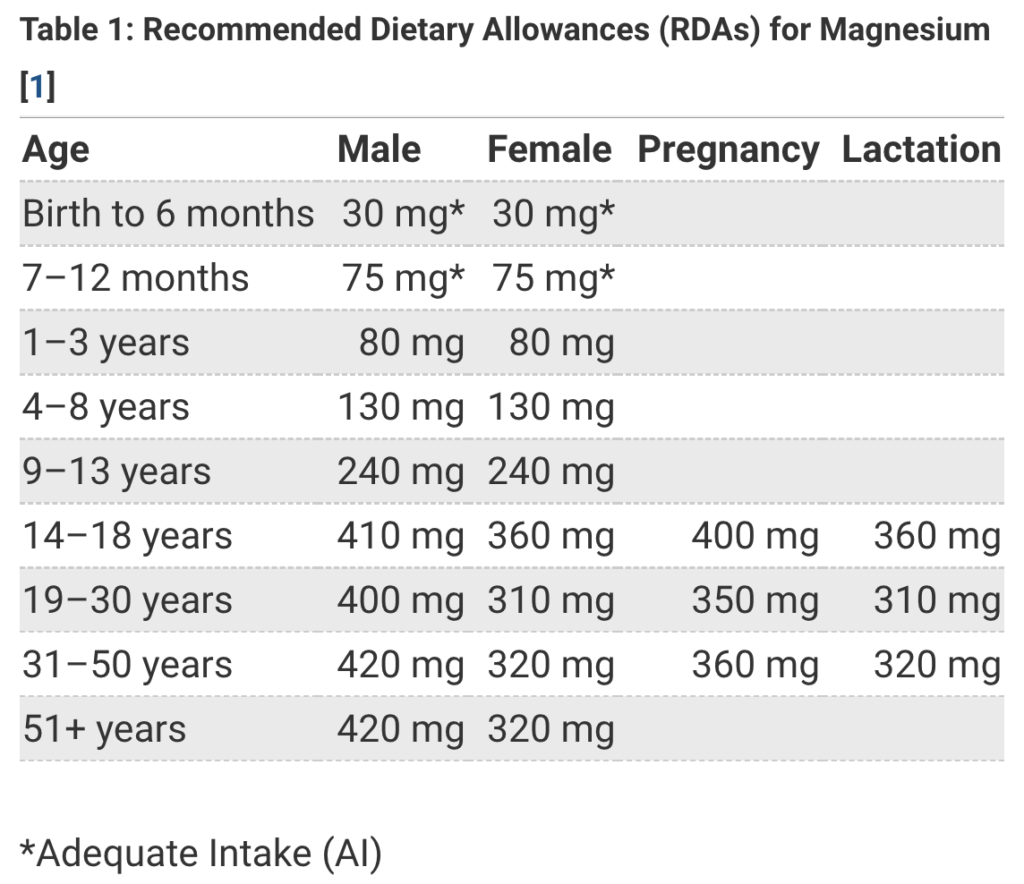
Magnesium: An essential nutrient that most people don’t get enough of
Page Contents:
Magnesium is an essential mineral for human health and optimal function. It plays an important role in bone and cell membranes, it’s involved in over 700 enzymatic reactions, and it’s required to synthesize DNA, RNA, and proteins—the building blocks of life. Yet studies show that the majority of Americans don’t get enough of this crucial nutrient, and deficiency of magnesium is associated with wide range of health problems, from cardiovascular disease to dementia to osteoporosis.
Read on to learn why magnesium is so important, how much you need for optimal health, and how you can ensure adequate magnesium levels through both diet and supplementation.
The essential functions of magnesium
Few compounds are more important to overall health than magnesium.
It’s involved in energy production, glucose regulation, the development of bone, muscle contraction, regulating normal heart rhythm, nerve function, and the production of glutathione, one of the most important antioxidants in the body.
In addition to magnesium’s direct actions, it also supports the functions of many other nutrients. For example, virtually all enzymes in the body that metabolize vitamin D require magnesium, and magnesium is required for the biosynthesis, transport, and activation of vitamin D. (1, 2)
Given these critical roles that magnesium plays, it’s no surprise that magnesium deficiency can produce a wide range of symptoms, including:
- Weakness
- Fatigue
- Nausea
- Headaches
- Loss of appetite
- Cravings for stimulants like coffee
- Vomiting
- Abnormal heart rhythm
- Muscle cramps
- Numbness or tingling
- And many more
Magnesium in health and disease
Maintaining adequate magnesium levels is one of the most important things we can do to promote optimal health and prevent and reverse disease. Conversely, sub-optimal levels of magnesium have been linked to a wide range of syndromes and diseases.
Cardiovascular health
Magnesium promotes healthy cardiovascular function via several mechanisms, such as helping to regulate cardiac muscle function and thus protecting against the development of arrhythmia and heart failure. It helps to prevent or delay calcification of the heart’s valves and arteries, and supports healthy endothelial (the inner membrane of blood vessels) function and blood vessel relaxation, contributing to healthy blood pressure. (3, 4)
In fact, magnesium is so important for cardiovascular health that people at high risk of heart attacks who consume the most magnesium have a 34 percent lower risk of death compared to those that consume the least. (5)
Metabolic health
Magnesium is an essential mineral when it comes to converting carbohydrates and fats into energy, as it is a cofactor for many of the enzymes involved in glucose metabolism. Studies have shown a clear dose-response relationship between magnesium intake and the risk of Type 2 Diabetes (T2D), with each increment of 100 mg/d of magnesium leading to an 8-13 percent reduction in the risk of T2D. (6)
Magnesium is also one of the most potent natural substances for lowering blood pressure. A review of 49 clinical trials found that, at appropriate doses, magnesium supplementation can reduce blood pressure in those with uncontrolled hypertension. (7)
Bone health
Magnesium is an essential element of the physical structure of bone tissue and helps contribute to maintaining bone mass. Magnesium also plays a role in the secretion of parathyroid hormone (PTH) and the expression of PTH receptors, regulating calcium levels in the body and supporting healthy bone remodeling—the lifelong process by which mature bone is removed, and new bone is formed. (8)
Studies have shown that magnesium supplementation increases bone mineral density in post-menopausal women with osteoporosis, primarily by suppressing bone turnover. (9)
Migraine and chronic headache
Magnesium supplementation has long been known to reduce the frequency and severity of migraines and headaches. With this in mind (and noting that research shows as many as half of all migraine sufferers may be magnesium deficient), researchers have gone so far as to say that “oral magnesium is warranted in all migraine sufferers.” (10)
In fact, a randomized, double-blind trial found that magnesium was as effective as two migraine medications at reducing migraine pain! (11)
Women’s health
A review of the use of magnesium in gynecology determined that magnesium deficiency may contribute to numerous women’s health concerns, such as dysmenorrhea, premenstrual syndrome, menstrual migraine, and postmenopausal symptoms, and that supplementation may help prevent or relieve these conditions. (12)
Cognitive and neurological health
Magnesium plays an important role in the brain and has multiple effects on cognitive and neurological function. Magnesium supports nerve transmission and neuromuscular conduction, and it prevents the death of brain cells. (13)
Studies have shown that low serum magnesium status is associated with a higher risk of dementia and that magnesium may protect against Parkinson’s, Alzheimer’s disease, and other cognitive and neurological disorders. (14, 15)
Mental and behavioral health
Magnesium has long been recognized as a crucial nutrient for mental and behavioral health. It’s involved in several functions within the central nervous system, including nerve transmission and signal transduction. (16)
A large systemic review found that low magnesium intake or blood levels are associated with depression, anxiety, ADHD, autism spectrum disorder, obsessive-compulsive disorder, and other mental and behavioral health disorders and that supplementing with magnesium may help to prevent or improve these conditions. (17)
Chronic pain
Because of magnesium’s muscle-relaxing effects and its effects on pain receptors, it has been shown to alleviate neuropathic pain, fibromyalgia, muscle pain, arthritis, and a wide range of other conditions that cause chronic pain. (18, 19)
Stress and HPA axis dysfunction
Magnesium works on many levels to help reduce the effects of stress and improves the body’s ability to relax (which also helps improve sleep). Studies have shown that not only does magnesium help to reduce stress, stress depletes magnesium. (20) This makes maintaining healthy magnesium levels critical for reducing the impact of stress.
Digestive health
Magnesium has a relaxing effect on the smooth muscle in the gut, which explains why it has been used in clinical practice as a remedy for constipation, abdominal pain, and gas and bloating for decades. A recent review found that magnesium is a safe and effective remedy for chronic constipation. (21)
Most people aren’t getting enough magnesium
The Recommended Dietary Allowance, or RDA, for magnesium varies by age, sex, and other factors, like pregnancy and lactation. The following table is from the National Institutes of Health Office of Dietary Supplements:

However, it’s important to note that the RDAs for magnesium were last published in 1997, using average body weights of 133 lbs for adult women and 166 lbs for adult men.
In 2021, researchers published a study arguing that the RDAs for magnesium should be updated to reflect the increasing average body weights of the US population. (21) They re-calculated the RDAs for magnesium according to the current average weights of male and female adults, and came up with the following values:
| Age and Sex | Revised RDA | Revised bodyweight |
| Women 19–30 | 450–514 mg/d | 168.5 lbs |
| Men 19–30 | 542–620 mg/d | 196 lbs |
| Women 31+ | 467–534 mg/d | 168.5 lbs |
| Men 31+ | 575–657 mg/d | 196 lbs |
The average intake of magnesium for US adults is 340–344 mg/d for men, and 256–273 mg/d for women. (22)
This means that most Americans are not getting enough magnesium—even if we use the lower, outdated RDA values. And Americans are falling far short of the recommended magnesium intake if we use the more accurate, updated RDAs based on current average body weight.
In fact, the average male and female over 31 years of age are consuming 200–300 mg/d less magnesium per day than they need.
This is a HUGE problem when you consider all of the benefits of maintaining adequate magnesium levels and the risks associated with not getting enough.
What’s more, we know that magnesium requires vitamin D to be absorbed in the intestine. (23) Given that up to 94 percent of Americans are deficient in vitamin D, this suggests that even those who are consuming enough magnesium (from food and supplements) may still be deficient. (24)
How to maintain healthy magnesium levels
Given what we know about the importance of magnesium for promoting optimal health and preventing disease, and given the study mentioned above, which calculated the revised RDA for magnesium, I would suggest the following daily intake targets:
- Women 19–30: 500–515 mg/d
- Men 19–30: 600–620 mg/d
- Women 31+: 520–535 mg/d
- Men 31+: 630–655 mg/d
How do we ensure that we meet these daily targets? There are two options: food and supplements.
Magnesium in food
The top food sources are:
- Green, leafy vegetables (e.g. spinach)
- Sea vegetables (e.g. agar, spirulina)
- Seeds (e.g. pumpkin, chia)
- Spices (e.g. coriander, chives)
- Cacao/chocolate
- Nuts (e.g. almonds, cashews)
While it’s important to eat as much magnesium-rich food as possible, it’s difficult to reach the optimal intake targets from food alone. There are three primary reasons for this.
First, only about 30–40 percent of the magnesium we consume in the diet is absorbed by the body. (25) Many foods that are rich in magnesium, such as spinach, are also high in compounds like oxalic acid which decrease magnesium absorption.
Second, due to changes in the quality of soil over the past few decades, the amount of magnesium found in the food that we eat has declined. Between 1940 and 1991, magnesium content in vegetables in the U.S. decreased by 24 percent, fruit by 17 percent, meat by 15 percent, and cheese by 26 percent. In the U.K., the decline was closer to 35 percent over that period. (26, 27, 28) Given that these data were published more than 30 years ago, it’s likely that today, the magnesium content in food is even lower.
Third, even if we ignore the first two points above, it can be difficult to eat enough high-magnesium foods each day. The table below from the National Institutes of Health lists the top 20 common sources of magnesium in the diet:

On a given day, if you ate 1 ounce of pumpkin seeds, ½ cup of boiled spinach, a baked potato, 8 ounces of yogurt, a banana, and 6 ounces of salmon, you’d be at 400 mg. But even this is a significant overestimate because of the factors mentioned above: declining soil quality and the fact that we only absorb 30–40 percent of the listed values of magnesium in food.
This means that, for the vast majority of people, supplementation with magnesium will be required to reach the optimal targets.
Magnesium in supplements
When supplementing with any nutrient, we must always consider which form will be best absorbed. The most common forms of magnesium found in over-the-counter supplements are magnesium oxide and magnesium citrate. While these are the cheapest forms you can get, they are often not the best to take because they are not well-absorbed. This can lead to undesirable gastrointestinal side effects, like sudden loose stools, severe gas, or an upset stomach.
Buffered chelated forms of magnesium are a much better choice. Chelation is a natural process that usually occurs in the small intestine in a person with optimal digestion. Minerals, such as magnesium, calcium, or selenium are bound to an amino acid or peptide, giving the molecule a structure that is more readily absorbed by the body. However, today many of us experience less robust digestion for many reasons, such as stress, rushed meals, and inflammation in the gut.
Taking a magnesium supplement that is already chelated allows you to quickly absorb and reap the benefits of magnesium without any non-chelated magnesium molecules making it into your gut to cause irritation and GI side effects.
This explains why buffered chelates of magnesium have been shown to be most effective for people with digestive problems, such as those with inflammatory bowel disease. (29)
So, when shopping for a magnesium supplement, look for the words “magnesium bisglycinate” and “chelate” and “buffered” on the label to make sure you’re getting the most bio-available form.
I hope you enjoyed this article, and it arms you with the knowledge and tools you need to optimize your magnesium intake—and thus protect your health and extend your lifespan!






